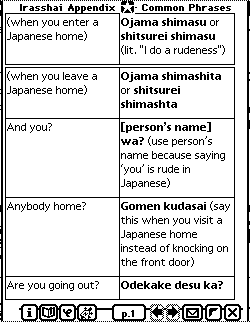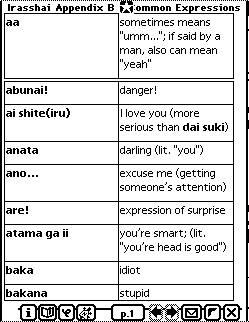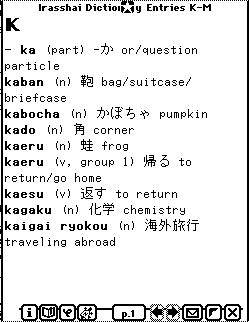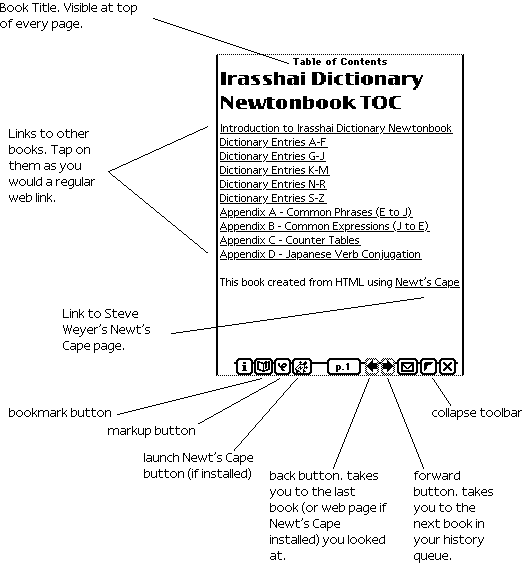日本語の辞書のNewtonbook 2.1!
Updated 6.12.2002
What's New?
Well, it certainly was a long time coming, but version 2.1 is ready to
go. I almost had it finished at the end of 2001 when some mildly
catastrophic events occurred, which threw my whole life off for nearly
5 months. I'm
happy to announce some new additions which I hope you'll find useful as
well as many new entries, clarifications, and error corrections.
What is it?
This is a Japanese-->English dictionary made by me to follow lessons
in the Georgia Public Television show, Irasshai , a distance
learning program that is broadcast by satellite to Georgia schools and
over the
air to Georgia home viewers. It was originally intended solely to be a
study aid for the TV show, but I have expanded it greatly since then.
There
is no English-->Japanese section except for the common phrases table.This
document and the introduction at the beginning of the Newtonbook are
the only
README information, so please read this document carefully. I keep
forgetting
to write an additional README doc for distribution. The dictionary is
not
very extensive at the moment, but I hope you find it useful. To NOS 1.x
users:
I'm very sorry, but this version of the dictionary is 2.x only; in
order
to make the desired improvements, I sacrificed portability.
Features
- Table of common phrases in English with their Japanese
equivalents
- Table of commonly used Japanese expressions with English
translation
- Table of counters for days, months, years, 10's, 100's, 1000's,
people, age, etc. Counters and numbers are confusing because they must
be pronounced a certain way, depending on the counter and the number.
This
easier to demonstrate than explain, so if you don't know what I'm
talking
about, please see the counter appendix.
- Explanation of verb conjugations (for the verb forms I've
learned) appendix. This is a brief tutorial for making plain, -masu,
-te, -nai,
-tai and potential form verb conjugations. I made this because when I
first
began learning Japanese, the verbs I wanted to look up in dictionaries
were never in plain form and I had no idea how to de-conjugate a verb.
It was extremely frustrating.
- Quick-ref explanation of verb + ending scenarios. Endings are
often strung onto Japanese verbs for clarity, to express intent, etc.
Verbs must be in a certain form depending on the ending used; for
example, v. stem
+ sou desu does not mean the same as v. plain + sou desu.
- Grammar quick reference appendix. Contains notes taken from my
lessonbooks such as wa and ga, giving and receiving,
how to use toki, and other complicated stuff. Not comprehensive.
What's Included?
This dictionary consists of 11 packages:
You can download each package directly into your Newton, or you can download a stuffed file
containing all of the packages (312k).
What else you'll need:
This dictionary uses, but does not requre, Tomoyoshi Murai's free font,
Kaname . One of the smaller Asian fonts, this font is about 212k on
your Newton. If you don't want to install additional fonts, the
dictionary will be displayed in "System", but there will be garbage
where the Japanese
text should be. All of the other information in the dictionary is
preserved.
Screenshots
Appendix A

|
Appendix B

|
Appendix C

|
Dictionary Entries

|
A Few Notes About Newt'sCape-generated books
When you read these books, you will notice that the controls at the
bottom of the screen may be different than those that you are used to
seeing. If you are new to this style of book, this diagram will help
you navigate through the book. Below is a screenshot of the table of
contents book.
As always, tapping Overview lets you quickly jump to document
sections.

Neither myself or the dictionary are in any way affiliated with GPTV.
Back to Main page
Last modified: 2002.6.13








